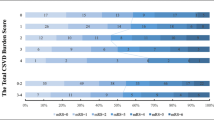Abstract
Multiple acute ischemic lesions in different hemispheres or vascular territories are mainly considered to be of proximal embolic origin. However, despite careful diagnostic work-up, the etiological classification often stays undetermined. We propose that multiple acute ischemic lesions can sometimes be a phenomenon observed in small vessel disease (SVD). From a prospectively collected database of more than 7,000 stroke patients, 173 patients with acute bihemispheric infarction were identified. We analyzed those subjects with multiple small (< 15 mm Ø) subcortical acute ischemic lesions on diffusion-weighted MRI (DWI) and concomitant severe small vessel disease (Fazekas grades II–III) without a proximal embolic source as evaluated by cardiological investigations. Twenty patients (mean age 66 ± 12 years, 12 men) with a mean number of 2.95 ± 1.24 acute lesions on DWI (range of 2–7 lesions per patient) were identified (n = 5 Fazekas II°, n = 15 Fazekas III°). Most of the lesions were located in typical areas of lacunar infarction. The mean NIHSS score on admission was 2.95 ± 2.0 (range 0–8). Multiple acute ischemic lesions in different vascular territories might not always be of proximal cardiovascular embolic origin. Simultaneous small subcortical ischemic lesions may reflect remote ischemia due to small vessel disease reflecting simultaneous hemorheological dysfunction.


Similar content being viewed by others
References
Arquizan C, Lamy C, Mas JL (1997) Simultaneous supratentorial multiple cerebral infarctions. Rev Neurol (Paris) 153:748–753
Ay H, Benner T, Arsava EM, Furie KL, Singhal AB, Jensen MB, Ayata C, Towfighi A, Smith EE, Chong JY, Koroshetz WJ, Sorensen AG (2007) A computerized algorithm for etiologic classification of ischemic stroke: the Causative Classification of Stroke System. Stroke 38:2979–2984
Ay H, Oliveira-Filho J, Buonanno FS, Ezzeddine M, Schaefer PW, Rordorf G, Schwamm LH, Gonzalez RG, Koroshetz WJ (1999) Diffusion-weighted imaging identifies a subset of lacunar infarction associated with embolic source. Stroke 30:2644–2650
Caso V, Budak K, Georgiadis D, Schuknecht B, Baumgartner RW (2005) Clinical significance of detection of multiple acute brain infarcts on diffusion weighted magnetic resonance imaging. J Neurol Neurosurg Psychiatry 76:514–518
Cho AH, Kim JS, Jeon SB, Kwon SU, Lee DH, Kang DW (2007) Mechanism of multiple infarcts in multiple cerebral circulations on diffusion-weighted imaging. J Neurol 254:924–930
Chowdhury D, Wardlaw JM, Dennis MS (2004) Are multiple acute small subcortical infarctions caused by embolic mechanisms? J Neurol Neurosurg Psychiatry 75:1416–1420
Fazekas F, Chawluk JB, Alavi A, Hurtig HI, Zimmerman RA (1987) MR signal abnormalities at 1.5 T in Alzheimer’s dementia and normal aging. AJR Am J Roentgenol 149:351–356
Fu JH, Lu CZ, Hong Z, Dong Q, Luo Y, Wong KS (2005) Extent of white matter lesions is related to acute subcortical infarcts and predicts further stroke risk in patients with first ever ischaemic stroke. J Neurol Neurosurg Psychiatry 76:793–796
Gold G (2009) Defining the neuropathological background of vascular and mixed dementia and comparison with magnetic resonance imaging findings. Front Neurol Neurosci 24:86–94
Gregoire SM, Charidimou A, Gadapa N, Dolan E, Antoun N, Peeters A, Vandermeeren Y, Laloux P, Baron JC, Jager HR, Werring DJ (2011) Acute ischaemic brain lesions in intracerebral haemorrhage: multicentre cross-sectional magnetic resonance imaging study. Brain 134:2376–2386
Gumbinger C, Krumsdorf U, Veltkamp R, Hacke W, Ringleb P (2011) Continuous monitoring versus HOLTER ECG for detection of atrial fibrillation in patients with stroke. Eur J Neurol
Kang DW, Chalela JA, Ezzeddine MA, Warach S (2003) Association of ischemic lesion patterns on early diffusion-weighted imaging with TOAST stroke subtypes. Arch Neurol 60:1730–1734
Lee SH, Bae HJ, Kwon SJ, Kim H, Kim YH, Yoon BW, Roh JK (2004) Cerebral microbleeds are regionally associated with intracerebral hemorrhage. Neurology 62:72–76
Maeder P, Bracoud L, Chabriat H, Gass A, Michel P, Hennerici M (2011) Design, data management, and population baseline characteristics of the PERFORM magnetic resonance imaging project. J Neurol 258:795–803
Rizos T, Rasch C, Jenetzky E, Hametner C, Kathoefer S, Reinhardt R, Hepp T, Hacke W, Veltkamp R (2010) Detection of paroxysmal atrial fibrillation in acute stroke patients. Cerebrovasc Dis 30:410–417
Rothwell PM, Villagra R, Gibson R, Donders RC, Warlow CP (2000) Evidence of a chronic systemic cause of instability of atherosclerotic plaques. Lancet 355:19–24
Seifert T, Enzinger C, Storch MK, Pichler G, Niederkorn K, Fazekas F (2005) Acute small subcortical infarctions on diffusion weighted MRI: clinical presentation and aetiology. J Neurol Neurosurg Psychiatry 76:1520–1524
Wardlaw JM, Sandercock PA, Dennis MS, Starr J (2003) Is breakdown of the blood–brain barrier responsible for lacunar stroke, leukoaraiosis, and dementia? Stroke 34:806–812
Conflicts of interest
None.
Author information
Authors and Affiliations
Corresponding author
Rights and permissions
About this article
Cite this article
Wolf, M.E., Sauer, T., Kern, R. et al. Multiple subcortical acute ischemic lesions reflect small vessel disease rather than cardiogenic embolism. J Neurol 259, 1951–1957 (2012). https://doi.org/10.1007/s00415-012-6451-4
Received:
Revised:
Accepted:
Published:
Issue Date:
DOI: https://doi.org/10.1007/s00415-012-6451-4




